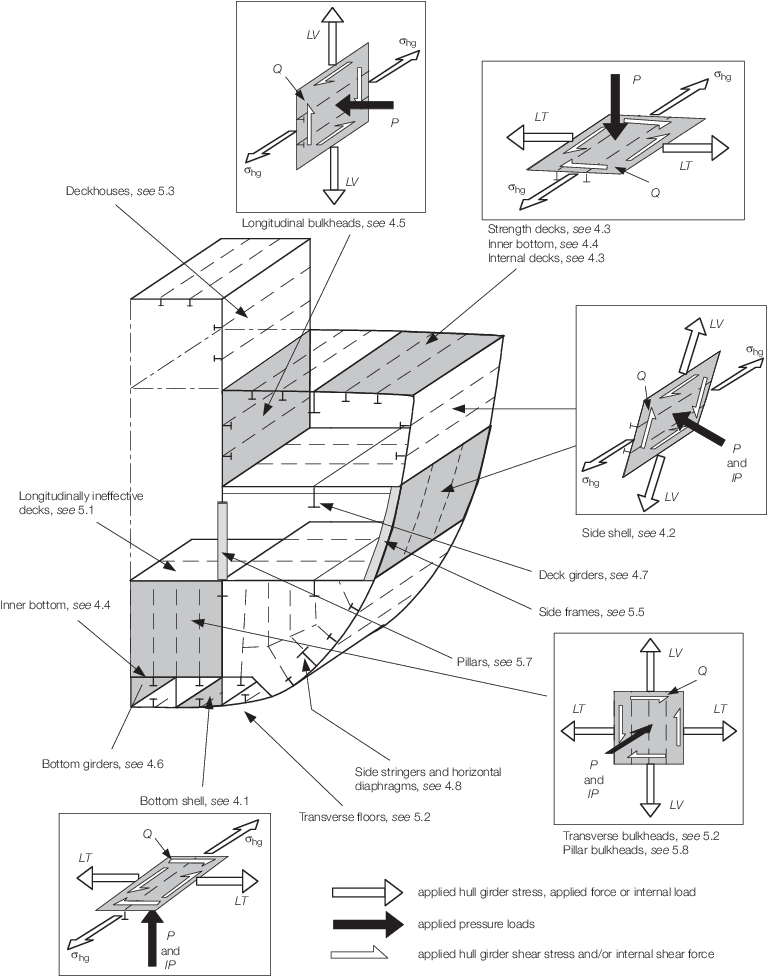
Section
1 General

1.1 Application
1.1.1 This
Chapter specifies the method by which the total design loads for the
optional Total Load Assessment, TLA, approach are derived.
The TLA approach is given in Vol 1, Pt 7, Ch 3 Total Load Assessment, TLA, an overview of the TLA approach is given in Vol 1, Pt 7, Ch 3, 1 Introduction and illustrated in Figure 3.1.1 Overview of the Total Load Assessment, TLA Procedure
1.1.4 The
total design loads given in this Chapter are applicable to all naval
ships which are operating in the displacement mode.
1.1.5 The
total design loads for ships that are operating in the planing or
non-displacement modes will need to be specially considered. The loads
given here are applicable for these ships whilst they are operating
in the displacement mode, i.e. in severe sea states when planing is
not possible.

1.2 Overview of total design loads
1.2.1 The
total design loads to be applied to each structural item are to include
the following load and pressure components where applicable:
- global hull girder stress due to vertical bending, σhg in
N/mm2, derived in accordance with Vol 1, Pt 6, Ch 4 Hull Girder Strength;
- global hull girder shear stress loads, τhg in N/mm2, derived in accordance with Vol 1, Pt 6, Ch 4 Hull Girder Strength;
- local pressure loads, P in kN/m2, where P is the appropriate design pressure value for each component;
- local transverse, LT, or vertical support, LV, loads, in kN;
- mass inertial forces, in kN;
- local shear force loads, in kN.
1.2.2 In addition
to the above loads, it may be necessary to consider the effects of
the following on the structural components:
- bending of primary structure supported by major bulkheads;
- bending of primary structure supported by the side shell or longitudinal
bulkheads;
- lateral bending moments and shear forces;
- global and local torsional moments.
1.2.3 Most
of the above load components include a dynamically fluctuating component
due to ship motions, e.g. side shell pressure due to wave and ship
motion. These loads will not all be maximum simultaneously, due to
their cyclic nature and the phase relationship between load values.
Consequently it is not necessary to apply the maximum values of all
these load components to the structure at the same time. Vol 1, Pt 7, Ch 2, 3 Design load combinations gives a method of combining
these loads in order that representative total design loads may be
applied to the structure.
1.2.5 Details
of all the loads applied to each structural component are to be supplied
to Clasifications Register (hereinafter referred to as 'LR').

1.3 Environmental conditions
1.3.1 The
environmental conditions for the determination of the total design
loads are to be based on the normal environmental design criteria
specified in Vol 1, Pt 5, Ch 2, 2.3 Wave environment unless
otherwise stated.
1.3.2 The standard values of wave height factor, fHs, and
service area factor, fs, given in Vol 1, Pt 5, Ch 3, 1.2 Environmental conditions 1.2.2 and Vol 1, Pt 5, Ch 2, 2.4 Service area factors, respectively, are to be used for the total design
loads unless otherwise stated. These factors may be adjusted for damaged loading
conditions, residual strength analysis, RSA, or for special operating conditions,
e.g. a temporary draught condition for the recovery of amphibious vehicles in sheltered
waters.

1.4 Direct calculations
1.4.1 Alternative
methods of establishing the total design loads will be specially considered,
provided that they are based on established codes or standards acceptable
to LR. In such cases, full details of the methods used are to be provided
when plans are submitted for approval.

Figure 2.1.1 Loads and stresses to be applied to the structure
1.4.2 Throughout
this Chapter, recommended values of effectiveness, ε, are given
for each structural component. These effectiveness values specify
the proportion of a particular load carried by a structural component
as opposed to other supporting structure, see the text
for more details. These efficiency values may be derived by direct
calculation, similar ship analysis or other suitable techniques. The
methods used and values derived are to be agreed with LR.
|